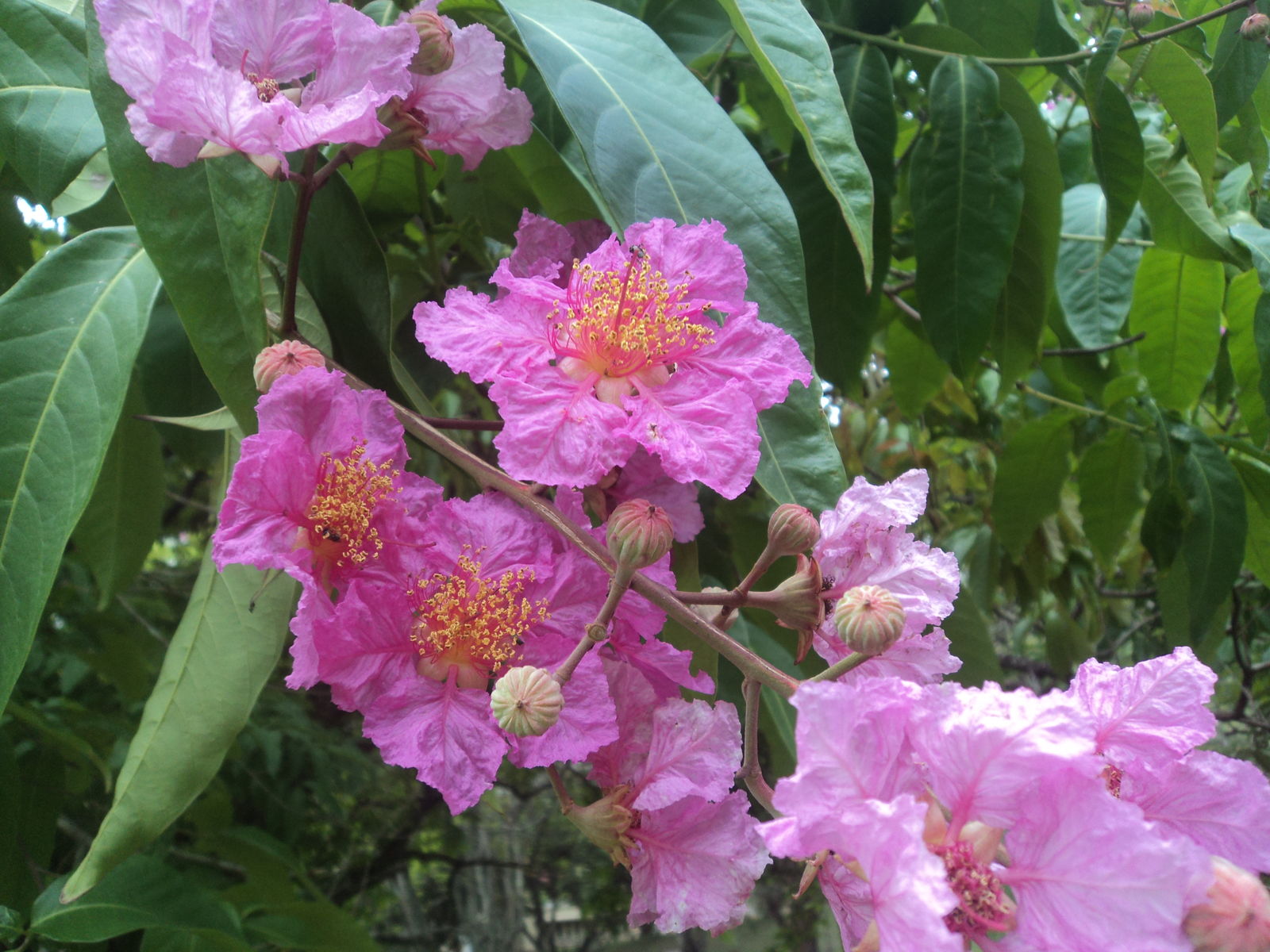Family: Lythraceae
Author: (L.) Pers.
Bibliography: Syn. Pl. 2: 72 (1806)
Year: 1806
Status: accepted
Rank: species
Genus: Lagerstroemia
Vegetable: False
Observations: China (Yunnan) to Trop. Asia
Description
Queen’s crape-myrtle, scientifically known as Lagerstroemia speciosa, is an illustrious plant recognized for its striking beauty and widespread cultivation. This vibrant species is native to a range extending from China’s Yunnan province to tropical regions across Asia, making it a prevalent figure in many warm-climate gardens and landscapes.
A proud member of the Lythraceae family, the Queen’s crape-myrtle stands out with its spectacular floral display. The blossoms, which can range from hues of pink and purple to magenta, are arranged in large, showy clusters, imparting a regal appearance that befits its common name. The flowering season is a remarkable episode, with the trees often covered in a profusion of blooms that create stunning swathes of color.
Apart from its ornamental value, Lagerstroemia speciosa serves various ecological and practical purposes. The plant’s deciduous nature means it provides seasonal interest, with leaves that transition through a spectrum of colors before shedding. Additionally, the bark exfoliates naturally, revealing a smooth, often multi-hued surface beneath, which adds to its aesthetic appeal even when the plant is not in bloom.
The Queen’s crape-myrtle is well-adapted to a variety of soil types and environmental conditions, though it thrives best in well-drained soils with ample sunlight. It is a resilient species, capable of withstanding drought conditions once established, making it a suitable choice for low-maintenance landscaping.
Beyond its beauty, Lagerstroemia speciosa holds cultural and medicinal significance in various regions. Parts of the plant have been traditionally used in folk medicine, particularly in tropical Asia, where it is valued for its potential health benefits.
In summary, the Queen’s crape-myrtle is not only a botanical gem due to its decorative flowers and adaptive qualities but also a plant with deep cultural roots and practical uses, making it a cherished choice among gardeners and plant enthusiasts across its native range and beyond.
Common Names
Spa: reina de las flores
Eng: pride of india, pride-of-india, queen’s crape-myrtle, queen’s-flower
Por: resedá-gigante
En: Queen’s crape-myrtle, Queen’s-flower, Pride-of-India, Pride of India, Crepe-myrtle, Crape Myrtle, Crape-myrtle, Crapemyrtle, Zi wei
My: Pyinma
Fr: Lilas des Indes, Goyavier fleur
De: Chinesische Kräuselmyrtle
Pt: Resedá-gigante, Escumilha
Pt-br: Resedá-flor-da-rainha, Resedá-gigante
Es: Reina de las flores, Lagerstroemia indica, Alstroemeria, Astronomía, Gastronomía, Júpiters
: Pride of india
Synonyms
- Lagerstroemia munchhausia (L. ex Forsyth f.)
- Murtughas speciosa ((L.) Kuntze)
- Munchausia speciosa (L.)
Distribution
- Assam (native)
- Bangladesh (native)
- Borneo (native)
- Cambodia (native)
- China South-Central (native)
- East Himalaya (native)
- India (native)
- Jawa (native)
- Laos (native)
- Lesser Sunda Is. (native)
- Malaya (native)
- Maluku (native)
- Myanmar (native)
- New Guinea (native)
- Philippines (native)
- Sri Lanka (native)
- Sulawesi (native)
- Sumatera (native)
- Thailand (native)
- Vietnam (native)
- Comoros (introduced)
- Cuba (introduced)
- Dominican Republic (introduced)
- Fiji (introduced)
- Haiti (introduced)
- Jamaica (introduced)
- Leeward Is. (introduced)
- Marianas (introduced)
- Puerto Rico (introduced)
- Trinidad-Tobago (introduced)
- Venezuelan Antilles (introduced)
Additional Images
Flower
Taken May 5, 2021 by Omolla Srikanth (cc-by-sa)
Taken Dec 7, 2022 by Francois Tron (cc-by-sa)
Taken Jul 2, 2021 by Dr. Usha Yadav (cc-by-sa)
Taken Jan 1, 2020 by Ember (cc-by-sa)
Taken Oct 13, 2021 by Dollis Caio (cc-by-sa)
Bark
Taken Sep 20, 2020 by Parzanes Robson (cc-by-sa)
Taken Mar 16, 2018 by Tela Botanica − Liliane ROUBAUDI (cc-by-sa)
Taken Nov 4, 2022 by Ibnu yusan (cc-by-sa)
Taken Mar 2, 2022 by Ball Darren (cc-by-sa)
Taken Jan 31, 2021 by Georgia C (cc-by-sa)
Fruit
Taken Dec 21, 2021 by ThaisDeSouzaGarcia (cc-by-sa)
Taken May 17, 2021 by philippe caprasse (cc-by-sa)
Taken Mar 1, 2017 by Hugo SANTACREU (cc-by-sa)
Taken Aug 23, 2020 by Sonu Mota (cc-by-sa)
Taken Oct 31, 2020 by Maradiaga Omar (cc-by-sa)
Leaf
Taken Mar 2, 2022 by Ball Darren (cc-by-sa)
Taken Jan 31, 2021 by Georgia C (cc-by-sa)
Taken Jun 25, 2020 by William Sanchez (cc-by-sa)
Taken Jan 4, 2020 by silva Feliicityy (cc-by-sa)
Taken Oct 13, 2021 by Dollis Caio (cc-by-sa)
Habit
Taken Jun 26, 2021 by victor singh ayam (cc-by-sa)
Taken Mar 6, 2009 by Tela Botanica − Liliane ROUBAUDI (cc-by-sa)
Taken Mar 2, 2022 by Ball Darren (cc-by-sa)
Taken Dec 16, 2020 by Jörg Spörle (cc-by-sa)
Taken Nov 15, 2019 by Rinaldi Rinaldi (cc-by-sa)
Other
Taken Aug 29, 2019 by cassia cassiafistula (cc-by-sa)
Taken May 12, 2021 by Karl Ahnee (cc-by-sa)
Taken Nov 4, 2022 by Ibnu yusan (cc-by-sa)
Taken Apr 27, 2019 by Mamadou NIAMBÉLÉ (cc-by-sa)
Taken Jul 29, 2021 by Nalini Mohan Denduluri IFS., (cc-by-sa)

© copyright of the Board of Trustees of the Royal Botanic Gardens, Kew.

© copyright of the Board of Trustees of the Royal Botanic Gardens, Kew.

© copyright of the Board of Trustees of the Royal Botanic Gardens, Kew.
Sources
- WFO (No URL)
- IPNI (No URL)
- GBIF (https://www.gbif.org/species/3188724)
- POWO (http://powo.science.kew.org/taxon/urn:lsid:ipni.org:names:553618-1)
- PlantNet (https://identify.plantnet.org/species/the-plant-list/Lagerstroemia speciosa (L.) Pers.)
Specifications
Growth habit>: Tree, Shrub






























